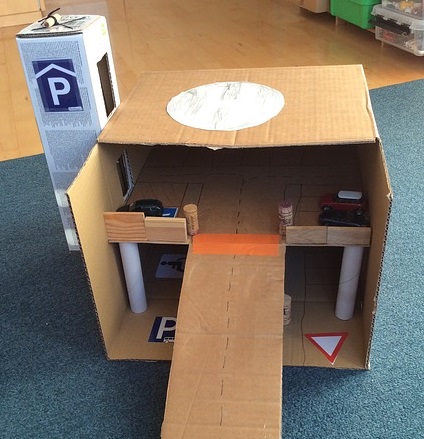Ch. 6 Project Based Learning
UQx LEARNx team of contributors
Project-based learning through developing the five attitudes of creative people
Developing deep learning competencies can be achieved in many ways, but one of the most exciting is through project-based learning.
- Project-based learning is a learner-centered pedagogy that involves learners identifying a real-world problem and engaging in hands-on learning to identify a solution.
Dr Melissa Cain from the School of Education at The University of Queensland notes in this next video how a deeper engagement with content can be developed through engaging in project-based learning.
Project based learning using Piirto’s five core attitudes – Watch video lecture (4:52 minutes)
Video Script
MELISSA CAIN: Do you have the right attitudes for deep learning? Jane Piirto, in her work ‘Creativity for 21st Century Skills’ identified five core attitudes that creative people possess. These are:
- self-determination
- openness to experience
- risk taking
- a tolerance for ambiguity
- group trust
We see these attitudes displayed in episodes of deep learning. One of the ways to further develop these attitudes and deep learning competencies is through project based learning.
In a nutshell, project based learning (or PBL for short) is learner-centered pedagogy applicable to all ages. It involves students identifying a real-world problem with authentic connections and engaging in a hands-on project to identify a solution.
Project based learning places emphasis on the process of inquiry over the final product. Through connecting with students’ interests, prior experiences, and family funds of knowledge, well-constructed projects excite and motivate students to work collaboratively on learning about a topic in depth over an extended period of time.
This includes students sharing their findings with others in insightful ways, and using a range of communication strategies to suit various learner preferences and abilities.
Through project based learning, students connect with experts in the real world to initiate a sustained inquiry.
In project based learning, student choice and student voice are critical elements in igniting intrinsic motivation, developing a sense of agency, and placing the learners as captains of their ship.
Project based learning has a focus on deep learning skills such as:
- critical thinking
- collaboration
- communication
- innovation
- creativity
Project based learning also fosters teamwork and positive social relations, and develops higher order cognitive skills so that learners engage in analyzing, synthesizing, justifying, evaluating, and creating. (Bloom’s Taxonomy)
To undertake such a project successfully, students will also need to demonstrate Piirto’s core attitudes of self- discipline, openness to experience, risk taking, a tolerance for ambiguity, and group trust.
- To summarize, project based learning involves an in-depth investigation of real world topics, manipulation of authentic objects, active learning through projects which occur over weeks or months, and is achieved through questioning experts, making observations, making connections, and demonstrating learning to others.
Project based learning incorporates the Universal Design for Learning (UDL) principles. These provide a framework that helps teachers plan learning activities to meet the diverse needs of all students.
These principles include multiple means of representation to allow for connections to be made by all students through varied means of presenting information, multiple means of action and expression so that students can choose topics, ideas, and information, as well as how to organize them, display them, and how they will present them for their chosen audience, and multiple means of engagement Students work with their own interests and on authentic problems.
Personal relevance and subjectivity is important. Students are engaged and motivated by their team and the technology they use. In future, you might like to consider developing learning activities that involve extended projects and which develop attitudes essential for moving students from surface to deep learning.
The Creative Arts Charter School video is useful for demonstrating a number of key concepts in motivating students for deep learning. Take the time to revisit this video and look for the following main concepts of project-based learning:
1. Learners working with a real-world issue that is presented in an authentic manner
2. Exploration of the topic begins with a ‘big question’ and extends over weeks or months
3. Learners connect with experts or ‘knowledgeable others’
4. There is an emphasis on the process of inquiry over the final product
5. There are opportunities for collaborative learning, teamwork, and the development of positive social relationships
6. Learners present their findings to others in insightful ways
Link to video: Creative Arts Charter School’s Approach to Project Based Learning (5.59 minutes)
[Tom Scott]. (2013, Jan. 16). Creative Arts Charter School Approach to Project-Based Teaching. [Video File]. Retrieved from https://youtu.be/1nq4gFp_vAY
The following are a few representative examples of the kinds of arguments typically made by advocates of project-based learning:
- Project-based learning gives students a more “integrated” understanding of the concepts and knowledge they learn, while also equipping them with practical skills they can apply throughout their lives. The interdisciplinary nature of project-based learning helps students make connections across different subjects, rather than perceiving, for example, math and science as discrete subjects with little in common.
- Because project-based learning mirrors the real-world situations, students will encounter after they leave school, it can provide stronger and more relevant preparation for college and work. The student not only acquires important knowledge and skills, they also learn how to research complex issues, solve problems, develop plans, manage time, organize their work, collaborate with others, and persevere and overcome challenges, for example.
- Project-based learning reflects the ways in which today’s students learn. It can improve student engagement in school, increase their interest in what is being taught, strengthen their motivation to learn, and make learning experiences more relevant and meaningful.
- Since project-based learning represents a more flexible approach to instruction, it allows teachers to tailor assignments and projects for students with a diverse variety of interests, career aspirations, learning styles, abilities, and personal backgrounds. For related discussions, see differentiation and personalized learning.
- Project-based learning allows teachers and students to address multiple learning standards simultaneously. Rather than only meeting math standards in math classes and science standards in science classes, students can work progressively toward demonstrating proficiency in a variety of standards while working on a single project or series of projects. For a related discussion, see proficiency-based learning.
The following are few representative examples of the kinds of arguments that may be made by critics of project-based learning:
- Project-based learning may not ensure that students learn all the required material and standards they are expected to learn in a course, subject area, or grade level. When a variety of subjects are lumped together, it’s more difficult for teachers to monitor and assess what students have learned in specific academic subjects.
- Many teachers will not have the time or specialized training required to use project-based learning effectively. The approach places greater demands on teachers—from course preparation to instructional methods to the evaluation of learning progress—and schools may not have the funding, resources, and capacity they need to adopt a project-based-learning model.
- The projects that students select and design may vary widely in academic rigor and quality. Project-based learning could open the door to watered-down learning expectations and low-quality coursework.
- Project-based learning is not well suited to students who lack self-motivation or who struggle in less-structured learning environments.
- Project-based learning raises a variety of logistical concerns, since students are more likely to learn outside of school or in unsupervised settings, or to work with adults who are not trained educators.

Reflection
How and why could the Problem- Based and/or Project-Based Learning, teaching methods to enhance opportunities for deep learning, motivation, equity, and inclusion of students with disabilities?
- Reflections from Robin Vogt, Granite State College School of Education teacher candidate
Finding inclusive educational balance with students who have disabilities is not an easy task. There are many factors that affect not only the student’s willingness to participate, but their ability to consistently be a contribution to the overarching educational goal(s) that is set by the teacher. Cooperative learning opportunities encompass everything that is good and right about education, and the success of an entire body of students. Most importantly, the special education population that makes up a percentage of this student body plays a large role in these successes as well. Deeper learning, motivation, equity and inclusion are all aspects of PBL (Project Based Learning) and the ultimate goal that surrounds its pedagogy.
As with any instructional practice, students should have clear expectations, and feel a connection to the content. Why am I learning this, and how can I use these skills in life? In that process, students (both populations) should be able to problem-solve, feel motivated by the task, and work with each-other as learners (not individuals) to achieve success. Project-Based Learning is built on “identifying real-world problems” and coming to a solution (UQx, 2017). When performing the necessary tasks involved, all students have an equal-opportunity at both completing the learning or find themselves coming to a conclusion on where things may have gone wrong. These experiences are not true to just one kind of learner; it crosses many levels of understanding and learning styles. Using Project-Based Learning inclusively allows students with diverse learning needs to interact with his or her peers on a leveled-playing field, all with the same purpose and drive at heart. Hearing the voices of peers that they (learners with diverse needs) understand and possibly look-up to is momentous and a deciding factor in the learning process. Classmates motivate and push each other to new limits when given the tools to do so. There is no single teacher that can do this, however, the experience of PBL (Project Based Learning) and the unique opportunity to be with classmates as a unified unit can create those deep-learning experiences.
Outlined by Bloom’s Taxonomy, “higher-order cognitive skills” can embrace the learning experiences created by PBL and cooperative teaching methodology. When exposed to the learning-methods and practices of his or her own peers, the student’s motivation to participate and be part of the strategy is increased dramatically. There are times, especially when discussing students with diverse learning needs, that the learner is spending quite a few hours in another setting on discrete trials or receiving IEP services. Their participation in the general-education classroom is often limited and held to a small period of time during the week. Socially, the inclusiveness of Project-Based, Problem-Based and cooperative-teaching learning is needed. Academically, the inclusiveness is influential. Personally, the experience created by all three pedagogues cannot be compared to any other facet of education. Encouraging and allowing learners with diverse learning needs to participate in these learning-formats can mean the difference between a really good day filled with exploration, and just another day of the same language and learning in the classroom. Not every day can be PBL, and we all know this as educators, however, when used at the right time, and within the right environment, the PBL undertaking can drive learning for many years to come. For our students with diverse learning needs, isn’t this what we want?
Thanks, Robin Vogt
UQx: LEARNx Deep Learning through Transformative Pedagogy. (2017). University of Queensland, Australia. (an Open edX MOOC). Project Based Learning
References
Project Based Learning. (2013). The Glossary of Education Reform. Retrieved from http://edglossary.org/project-based-learning/
UQx: LEARNx Deep Learning through Transformative Pedagogy (2017). University of Queensland, Australia


